9th September: The Revolution
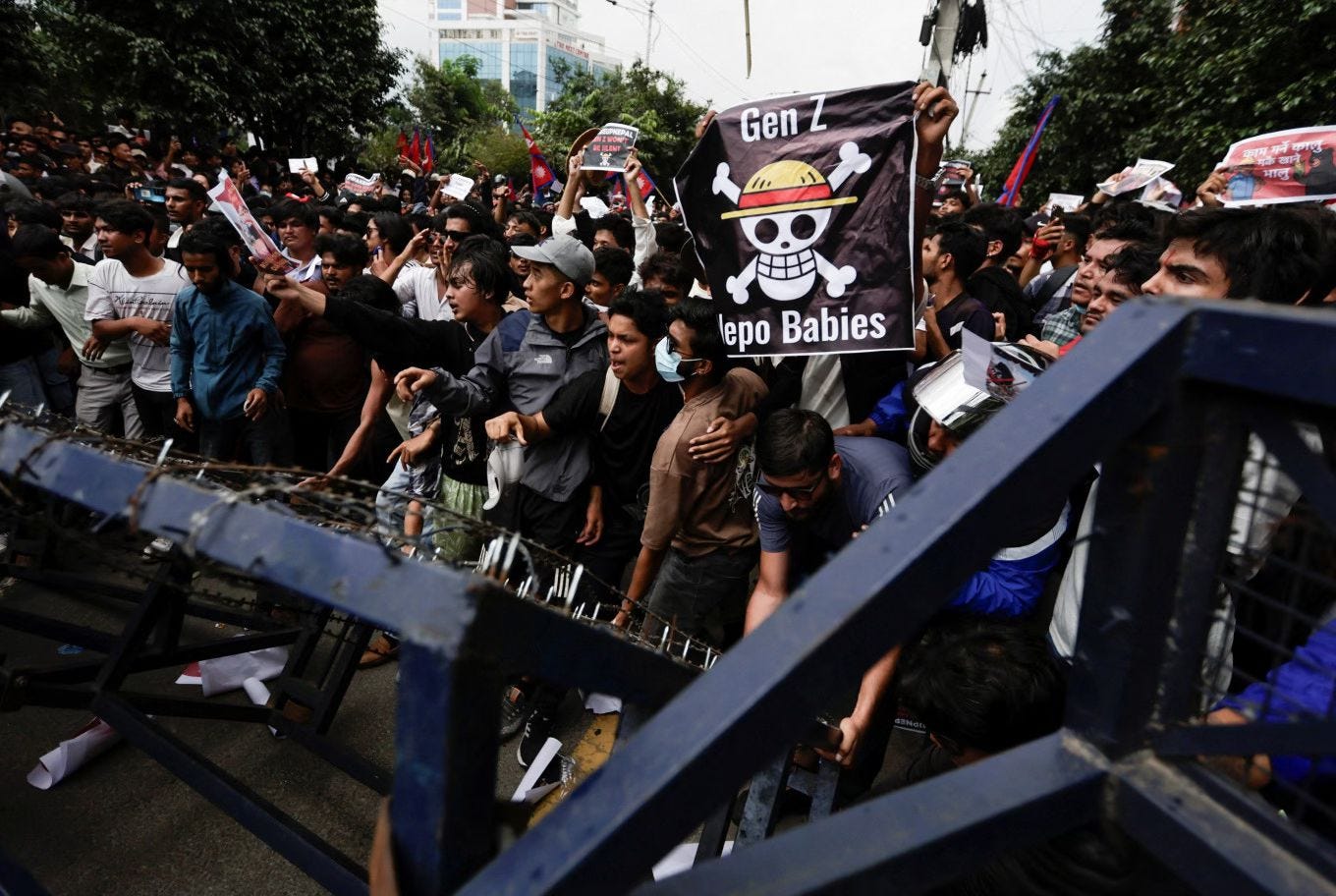
Protesters carrying flags and banners as they try to break through a police barricade on Sept. 8, 2025, during an anticorruption rally in Kathmandu. (Reuters/Navesh Chitrakar)
Following the tragedies of 8th September, all citizens were enraged. The unethical open fire on the peaceful protesters led to the deaths of 21 martyrs, and hundreds were injured. The tragedy also gained pace through social media outlets; many INGOs, like UN Human Rights (UNHR) and Human Rights Watch, alongside international news channels, covered the incidents and strongly criticized the Nepali government.
To try to ease the worsening situation, former Home Minister Ramesh Lekhak resigned on moral grounds, taking accountability for the lives lost. The government also lifted the ban on major social media platforms the same evening.
However, the government failed to realize that only unbanning the social media platforms was not enough, as in the first place, the protest was against the corrupt government itself, particularly the three major political parties: The Nepali Congress, CPN UML, and the Communist Party (Maoist Centre), and their party leaders.
People demanded the resignation of former PM Khaka Prasad Oli, party leader of CPN UML, and to take accountability for 21 lives lost. However, he did not make any public statement that day.
Instead, an indefinite curfew was imposed in Kathmandu from 4 p.m. onwards to control the protesters and reduce their movements.
September 9th: The Dawn of Revolt
On the Morning of 9th September, a curfew was imposed in the eight major cities where protests had taken place. Children woke up to closed schools, and adults woke up to closed offices and workplaces.
However, it was defied. Instead of empty streets, all major cities were filled with outcries and defiant voices. This time around, things were different. With the curfew, everybody got a chance to raise their voice. By 6 a.m., masses took to the streets by the tens of thousands. Everybody marched from their homes, raising voices against the government, the corrupt leaders, and especially the former PM K.P. Oli and the Armed Police Force. Chanting slogans, the crowds only became larger. It was clear something was about to happen.
Around 5:30 a.m., thousands had already flooded Kathmandu’s Maitighar Mandala, marching towards the Federal Parliament and Singha Durbar. The police initially retaliated; however, no official orders had been given to the Armed Police Force (APF) that morning. Home Minister Lekhak resigned the other day, and Chief District Officer (CDO) Chabbi Rijal wasn’t responsive. Throughout the country, masses gathered around major government offices, police stations, and the houses of corrupt politicians.
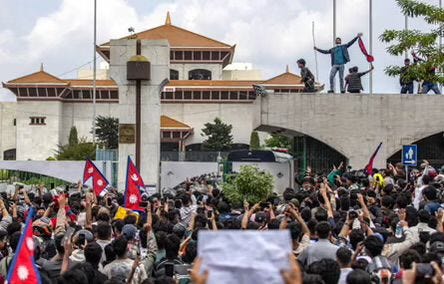
Demonstrators gather outside Nepal’s parliament in Kathmandu on Monday. Photograph: Prabin Ranabhat/AFP/Getty Images
By mid-morning, the government imposed a nationwide curfew, while it had only imposed it in certain locations earlier that morning. 25 parliament members from the entire Rastra Swatantra Party (RSP) resigned. The civil unrest also escalated, and demonstrators stoned and vandalized major government offices. Almost all police stations, including traffic police, police stands, and checkposts, were torched. Soon, the houses of alleged corrupt politicians were also surrounded, vandalised, and torched from mid-morning.
From 10 a.m. onwards, a wave of attacks spread across the Capital and throughout the nation.
The APF slowly backed off after control attempts with the use of tear gas and rubber bullets failed, while the Army focused on rescuing the minister rather than protecting private properties and government quarters.
Hours later, at around 2 p.m., Khadka Prasad Oli resigned from his post of Prime Minister, citing “the extraordinary situation” in his resignation letter, alongside four other ministers.
What did it take?
- 10:00 a.m. IT Minister Prithvi Subba Gurung’s house was vandalized and torched in Sunakothi, Lalitpur.
- 10:10 a.m. Prachanda Niwas was vandalized and burned in Khumaltar.
- 10:50 a.m. Former PM KP Oli’s residence in Balkot, Bhaktapur, was surrounded and attacked.
- 11:00 a.m. Ullens School vandalized and partially torched, transport vehicles outside set ablaze and exploded.
- 11:20 a.m. Sudurpaschim Chief Minister’s office in Dhangadi vandalized.
- 11:30 a.m. Ram Chandra Poudel’s residence at Balaju, Kathmandu, was torched.
- 11:32 a.m. Kirtipur Municipality set on fire.
- 11:40 a.m. Former PM Sher Bahadur Deuba and Minister Arzu Rana Deuba’s residence in Budanilkantha vandalized and torched; bulk bags of U.S. Dollars discovered.
- 11:40 a.m. Nepali Congress HQ at BP Nagar, Lalitpur, torched.
- 11:45 a.m. Former HM Ramesh Lekhak’s house set ablaze at Naikap, Kathmandu.
- 11:50 a.m. Minister Gagan Thapa’s residence torched at Ratopul, Kathmandu.
- 11:55 a.m. Minister Prakash Man Singh’s residence set ablaze; UML HQ at Chyasal, Lalitpur, torched.
- 11:45 a.m. Former HM Ramesh Lekhak’s private residence set ablaze in Naikap, Kathmandu
- 11:55 a.m. CPN UML HQ at Chyasal, Lalitpur, set ablaze.
- 12:20 p.m. CPN-UML Minister Mahesh Basnet’s residence was vandalized and pelted.
- 12:50 p.m. CPN-UML Minister Gokul Baskota’s residence was vandalized in Lokanthali, Bhaktapur.
- 1:10 p.m. Hilton Hotel, Kathmandu, set ablaze.
- 1:20 p.m. Minister’s quarters at Bhaisepati Lalitpur vandalized, some torched.
- 1:20 p.m. Energy Minister Deepak Khadka’s residence vandalised and torched.
- 1:25 p.m. Former PM Jhala Nath Khanal’s residence at Dallu, Kathmandu, vandalized and set ablaze.
- 1:30 p.m. Former PM Madhav Kumar Nepal’s residence at Koteshwor, Lalitpur, was Pelted.
- 1:50 p.m. Singha Durbar breached, protesters enter and vandalise the executive and administrative office of Nepal.
- 2:00 p.m. Finance Minister Bishnu Prasad Poudel’s residence was surrounded and pelted in Bhaisepati, Lalitpur.
Gen-Z, alongside all Nepalis, had truly won. Thousands of Gen-Z protesters outside Singha Durbar and Federal Parliament erupted in celebration with chants and dances, waving the Nepali flag with pride and unspeakable emotions.
Oli’s oppressive governance was toppled. The same Generation-Z he called “Thagi Khane Bhada” had forced him to flee, while the Revolution of 2082 would forever be written in history. It was over; The citizens had triumphed over the hypocritical and corrupted government that once sidelined our generation from their conduct.
Yet, amid the cheerful celebrations, a sour truth remained: the protest was a body without a head.
The Headless Mass
The victory was short-lived, as the demonstrations soon turned into directionless destruction. The majority of peaceful protesters dispersed, but the masses remained. The protest was united by the grief of Nepalese and their hate for the corrupt leaders; however, there was no structure of protest nor a visionary leader.
Since the resignation of HM Ramesh Lekhak, the Armed Police Force was under the command of CDO Chhabi Rijal, acting in accordance with the ex-PM K.P. Oli. However, the protesters’ numbers were too huge for proper crowd control mechanisms. The APF did not have the ability to restrain the situation. APF reached out for help to the Nepal Army; however, the Army strictly denied any help, citing that they would not kill the citizens to control them. IGP Chandra Kuber Khapung was unable to mobilize the APF and form an order due to uncontrollable chaos and inadequate policemen. It was not wise to shoot and disperse the crowd either; thus, the police retreated, and no order was given to the APFs throughout the country.
After ex-PM Oli’s resignation and no police intervention, the country delved into hours of anarchy.
Opportunistic agitators, criminal elements, or possible provocateurs from political factions unaligned with Gen-Z’s original movement escalated situations nationwide. They took the opportunity of the chaos, with no police intervention, and they were free to do whatever they wanted.
Due to no orders being given to the APF, around 2 p.m., a mob of 800-1000 people breached the Koteshwor Police station. Firearms, rifles, pistols, and ammunition were looted and used in demonstrations, and three policemen died. Firearms from the District Police Office, Pokhara, were also looted.
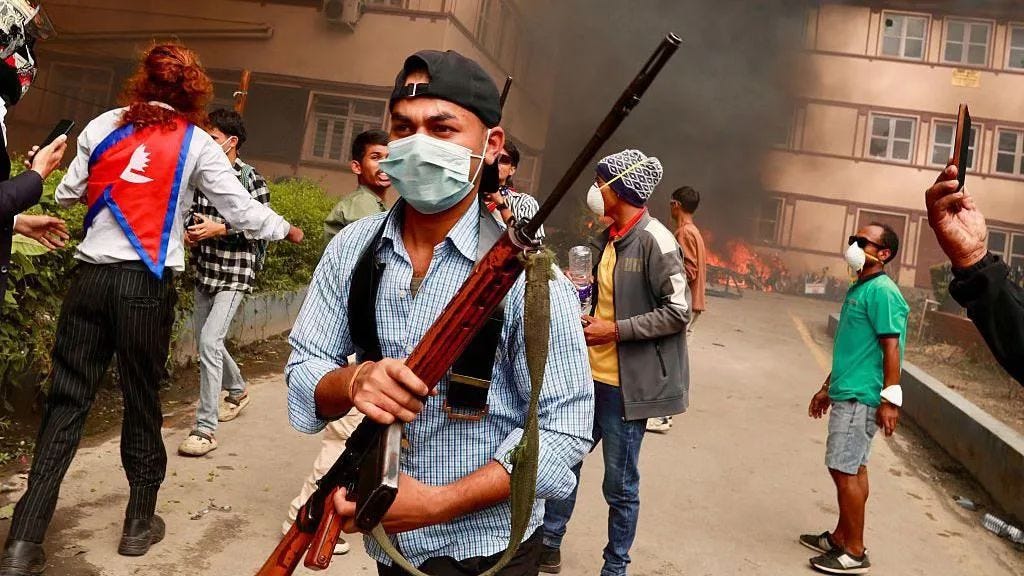
Demonstrators getting hold of guns and ammunition from protest sites, 9th September 2025.
After 3 p.m., the chaos only escalated. With the police’s retreat, a lot of unethical vandalism and looting cases took place.
By the afternoon, 21 of 27 Bhatbhateni outlets were vandalised, 12 fully torched. The Lainchaur Building of Ncell Telecom and Kantipur Business Centre were partially torched. Educational Institutions like Global College, Nami College, and Ullens School were fully torched due to their political affiliations.
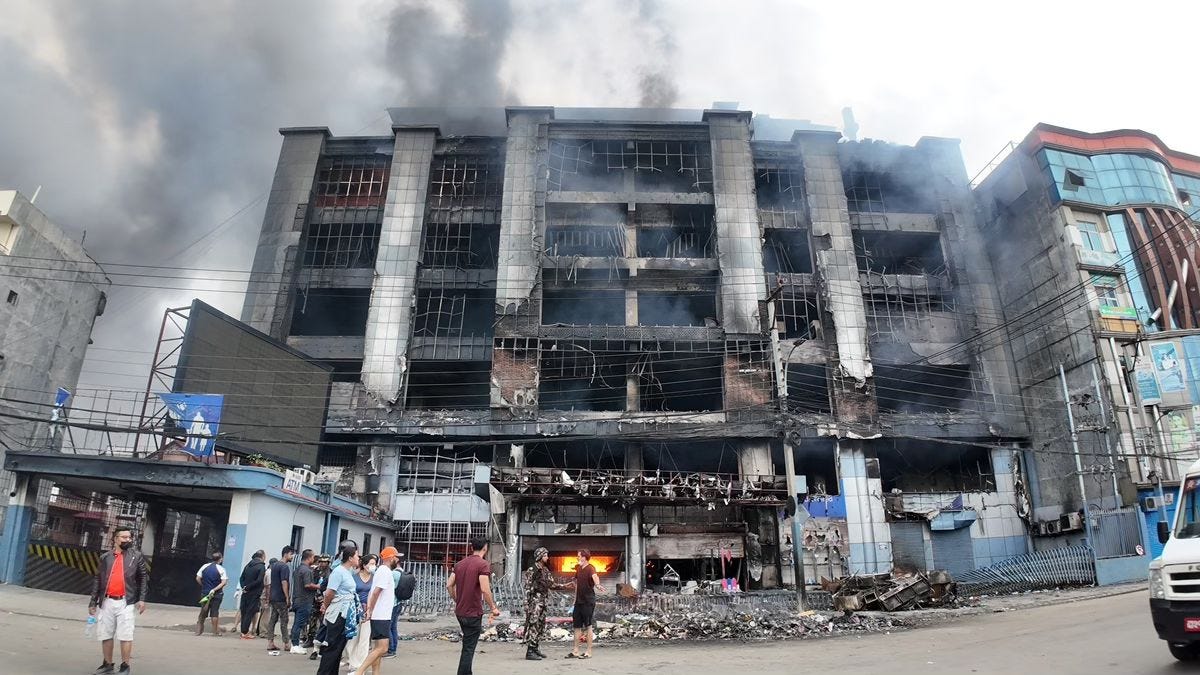
One of the BhatBhateni Outlets being torched and vandalised, 9th September
Labim Mall, Chhaya Centre, and many other malls and complexes were looted and vandalised. Numerous and uncountable jewelry shops, liquor stores, and a variety of shops were also damaged.
By 4 p.m., Infiltrators had fully torched the Federal Parliament (Samsad Bhavan) in Baneshwor. And an hour later, by 5 p.m., Singha Durbar was also set ablaze. Despite many voicing against the torching of Singha Durbar, the main executive body of Nepal, where many important documents and data forming the foundation of our sovereignty as a nation lay, it was torched.

The Federal Parliament Building of Nepal was surrounded by protesters and torched, 9th September.
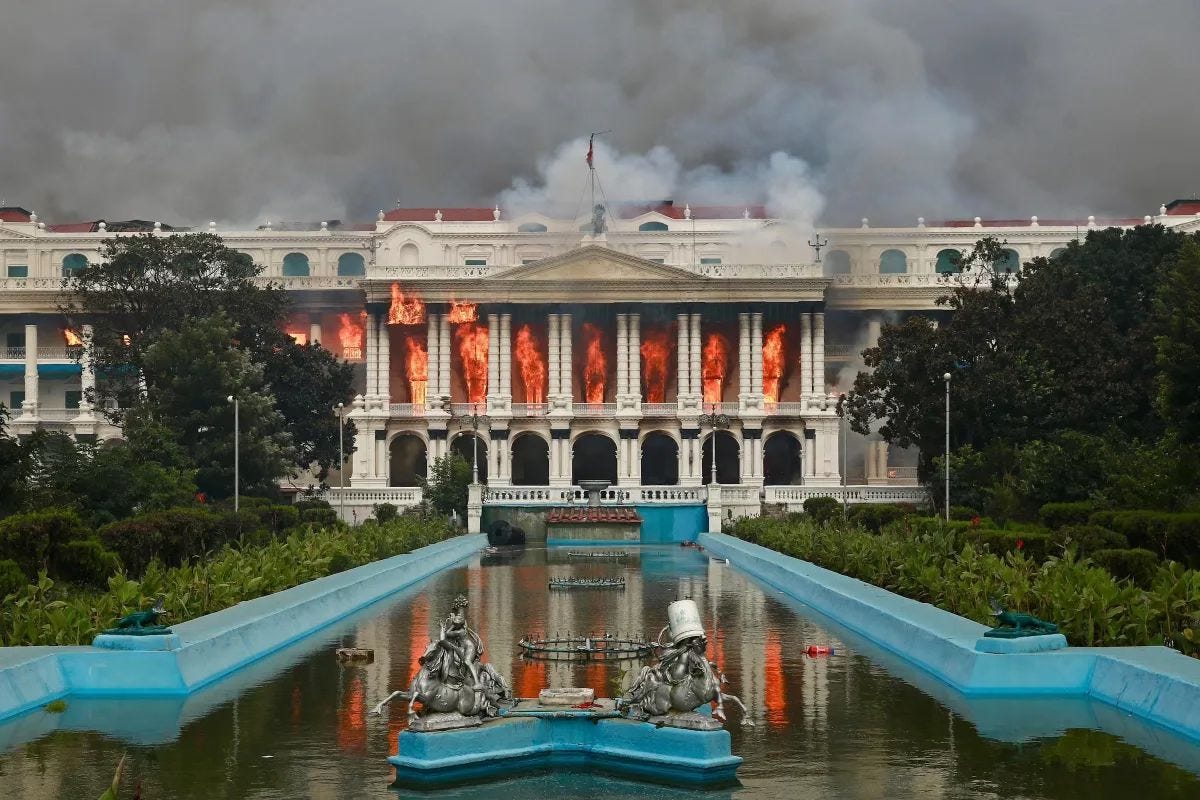
Singha Durbar, a historic 170-year-old executive building of Nepal, and the office of the Prime Minister, are burning on 9th September.
By 6 p.m., protesters had also torched one of the buildings of Nepal Rastra Bank (NRB), and the Supreme Court of Nepal. Provincial Assemblies in Gandaki, Bagmati, and several other provinces were also vandalised.
However, the situation escalated even more. Due to a thinning police presence and security, jails and prisons were also covered by a small number of policemen. With large numbers of agitators and infiltrators overpowering the thin security, jailbreaks happened nationwide.
Over 13,500 inmates escaped from prisons and jail facilities. The most important ones covered by the news are: Dillibazar Jail (1,100), Chitwan (700), Nakkhu (1,200), Jhumpka in Sunsari (1,575), Kanchanpur (450), Kailali (612), Jaleshwar (576), Kaski (773), Dang (124), Jumla (36), Solukhumbu (86), Gaur (260), and Bajhang (65).
What began as a revolution led by the youth, with many hopes and aspirations, turned into uncontrollable anarchy, with anybody doing whatever they pleased.
The Aftermath
By 7 p.m., more than 13,500 inmates had broken out of prison nationwide. Shops and malls were being looted due to a lack of police force enforcing security.
Rastra Banijya Bank and the Himalayan Bank were also breached. Millions of rupees were stolen by looters and criminals.
There were no public orders given to the Armed Police Force (APF) by the CDO Chabbi Rijal regarding security concerns. The Home Minister and the Prime Minister had also resigned; thus, the nation fell into the hands of President Ram Chandra Poudel and Chief of Army Ashok Raj Sigdel.
With thinning security for even the common people, and no police intervention, Chief Ashok Raj Sigdel soon made a public statement and ordered the armed army to enforce security and imposed a curfew throughout the nation. Roadblocks were set up, and intersections were heavily guarded by the army, as the risks of stolen guns and weapons were still there.
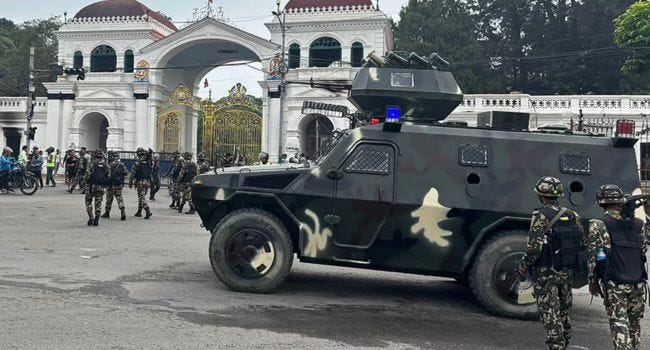
Nepal Army deployed on the streets with guns to ensure the safety of citizens and halt prison escapees after the curfew, the morning of 10th September.
The lives of even the common people were in jeopardy, with thousands of criminals escaping prisons. Due to the army’s control, the criminal activities calmed down after 8 p.m., while many inmates had started to be caught by the army.
By midnight, many questions arose. What would happen to the nation? Where was the nation headed?
Nepal was no longer under the reign of corrupt politicians, but now, under the boots of the army. Some feared a military government, or even a constitutional monarchy, due to many secret political agendas being hidden around the army and other public officials.
Now that Gen-Z had toppled the government, without a clear leadership, vision, or unity, a vacuum followed. Chief Ashok Raj Sigdel asked to have talks with the leaders of the Gen-Z movement, but it was met with uncertainty. The movement had no head or a clear leader; some were part of factions, while the majority were there on their own.
Some popular names amongst the people were: Balen Shah, the mayor of Kathmandu, who had been called out by many protesters and Gen-Z to have talks with the army, and even possibly be the interim prime minister. Harka Sampang, the mayor of Dharan, also came forward, proposing to have talks with the Chief of the Army and the President. But there wasn’t a clear face of Gen-Z.
There were a few lesser-known emerging names among the Gen Zs, too. Sudan Gurung, the founder of Hami Nepal, although a millennial, was present during the protest and had a large faction in both protests of September 8 and 9. Other names like Miraj Dhungana and Aashika Tamang also popped up.
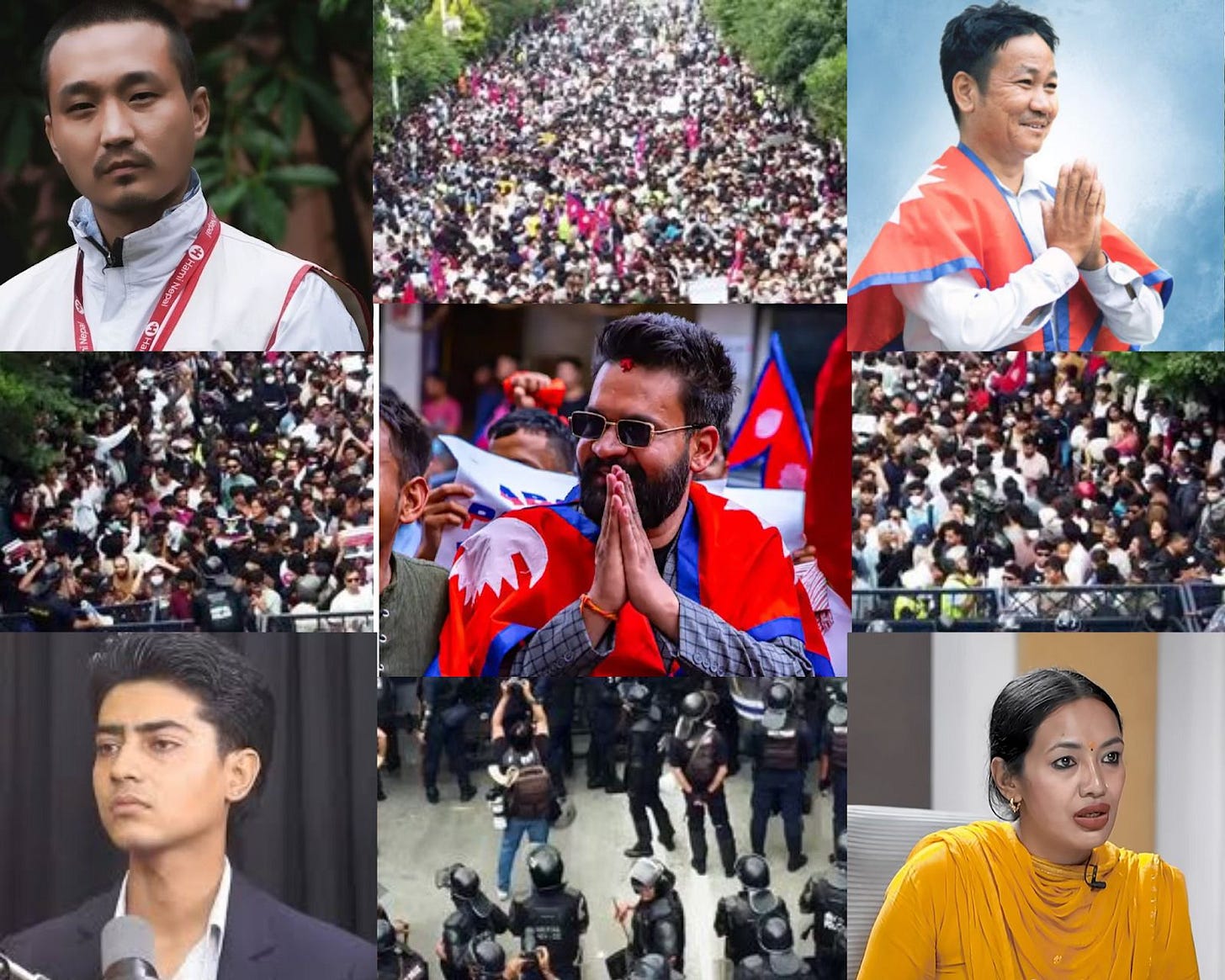
Common names that popped up among the Gen-Z for the talks with Chief Ashok Raj Sigdel
Ultimately, the night of September 9 was a fragile one for the entire nation. The corrupt leaders were gone, but no new leadership had risen to take their place. The path that lay ahead for Nepal was crucial but mysterious. The night ended with more questions than answers and an unwritten future.
